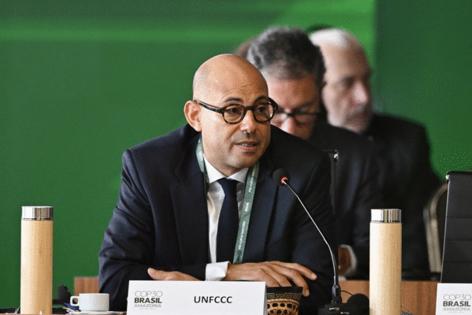UN sees world's emissions falling 10% by 2035, far short of 60% goal
Published in News & Features
Global emissions of planet-warming greenhouse gases are expected to fall by about 10% by 2035, compared with 1990 levels, representing the first decline ever forecast by the United Nations. But the world remains well off course to keeping global warming below the 1.5C leaders committed to when they signed the Paris Agreement a decade ago.
“Humanity is now clearly bending the emissions curve downwards for the first time, although still not nearly fast enough,” Simon Stiell, executive secretary at the U.N. Framework Convention on Climate Change (UNFCCC), said on Tuesday. “We have a serious need for more speed.”
Carbon emissions are already impacting people’s lives and economies, with droughts, storms and heat waves killing thousands and causing billions of dollars in economic losses every year. Addressing the gap between current emissions levels and where scientists say they should be is a herculean challenge facing countries at the COP30 climate summit in Brazil next month.
The decline predicted by the U.N. is based on promises made by countries representing about 80% of global emissions. It falls well short of the 60% cut by 2035 that scientists say is needed to keep warming close to 1.5C by the end of the century and avoid catastrophic climate change.
“This report lays bare a frightening gap between what governments have promised and what is needed to protect people and planet,” Melanie Robinson, global climate, economics and finance program director at the World Resources Institute, said in a statement. “While the transition to a low-carbon economy is underway, it’s clear that countries need to shift from a jog to an all-out sprint.”
On Tuesday, the UNFCCC also released its NDC Synthesis Report, based on countries’ detailed plans known as Nationally Determined Contributions, or NDCs. The Paris Agreement says NDCs must be lodged every five years, and a round of submissions was due in 2025. But only 64 countries — representing about a third of global emissions — submitted them by Sept. 30, in time for the U.N. to make the calculations necessary to produce the report.
China, the world’s biggest polluter, has set a target to cut economy-wide net greenhouse gas emissions by 7% to 10% over the next decade, but it hasn’t yet formally submitted that goal to the U.N. The European Union is aiming to find consensus among its 27 member states on its plan on Nov. 4 — too late for the synthesis report but in time for COP30. India hasn’t signaled when it will deliver its NDC.
Brazil, the U.K. and Norway were among the countries whose climate pledges were included. There’s also a U.S. plan submitted under former President Joe Biden. But that’s unlikely to be implemented under current President Donald Trump.
The 64 NDCs analyzed may result in a reduction in emissions of 17% by 2035 from 2019 levels. If their plans are implemented, the group of countries’ emissions would peak before 2030 and then fall sharply after 2035, and most of the nations would reach net zero by 2050 — all necessary steps to avoid dangerous warming.
The UNFCCC highlighted that for the first time, most climate plans include all sectors of the economy and have higher quality and credibility. They also go beyond cutting emissions — known as mitigation — and include elements like adaptation, finance, technology transfer, capacity-building, and addressing economic loss and damage from climate change.
Unlike previous editions of the NDC Synthesis Report, this year’s doesn’t include a temperature estimate for global warming by the end of the century. That’s because the sample is too small. The U.N. plans to update the report in the coming days and a new edition may include a temperature estimate. Last year, the U.N. projected temperatures by 2100 would be between 2.1C and 2.8C higher than in pre-industrial times.
Over the past week, South Africa, Malaysia and Indonesia have submitted their NDCs, and more countries are expected to do so ahead of and during the COP30 leaders’ summit in Belém, Brazil, on Nov. 6 and Nov. 7.
How to close the gap to 1.5C is one of the key barometers for success at the meeting. It’s also likely to be one of the biggest fights. While nations that are progressive on climate, including in the E.U., are pushing for stronger mitigation efforts, others, such as Saudi Arabia and India, are staunchly opposed.
©2025 Bloomberg L.P. Visit bloomberg.com. Distributed by Tribune Content Agency, LLC.







Comments